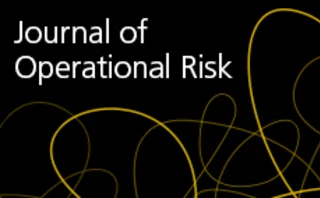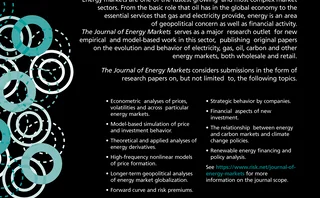Journals
An internal default risk model: simulation of default times and recovery rates within the new Fundamental Review of the Trading Book framework
This paper presents a new default risk model for market risk that is consistent with these requirements. The recovery rates follow a waterfall model that is based on a minimum entropy principle.
Hedging incentives for financial institutions
Using a simple model, this paper derives two results that provide guiding principles for hedging by, and capital regulation of, financial institutions.
Should we invest more in multinational companies when domestic markets decline?
This paper uses a twenty-year data set of all publicly listed US firms from 1995 to 2014 to create a unique measure of both the extent and the scope of firm-level multinationality.
Interdependencies in the euro area derivatives clearing network: a multilayer network approach
This paper provides insight into how the collected data pursuant to the EMIR can be used to shed light on the complex network of interrelations underlying the financial markets.
Mapping bank securities across euro area sectors: comparing funding and exposure networks
In this paper, the authors present new evidence on the structure of euro area securities markets using a multilayer network approach.
Scoring models for roboadvisory platforms: a network approach
In this paper, the authors show how to exploit the available data to build portfolios that better fit the risk profiles of investors. This is made possible, on the one hand, by constructing groups of homogeneous risk profiles based on user responses to…
Second-order Monte Carlo sensitivities
This paper considers the problem of efficiently computing the full matrix of second-order sensitivities of a Monte Carlo price when the number of inputs is large.
Extremal risk management: ES value verification
In this paper, we refer to the axiomatic theory of risk and investigate the problem of formal verification of the expected shortfall (ES) model based on a sample ES. Recognizing the infeasibility of parametric methods, they explore the bootstrap…
Supervisory stress testing for central counterparties: a macroprudential, two-tier approach
This paper examines the role of supervisory stress testing of central counterparties (CCPs). A key message is that the design of supervisory stress tests (SSTs) should be tailored to CCPs’ roles, risk profiles and financial structures.
Near-real-time monitoring in real-time gross settlement systems: a traffic light approach
This paper develops a method to identify quantitative risks in financial market infrastructures (FMIs) that is inspired by the Principles for Financial Market Infrastructures.
Volatility forecasting: the role of internet search activity and implied volatility
In this study, the authors search for a benchmark model with available market-based predictors to evaluate the net contribution of internet search activity data in forecasting volatility. The paper conducts in-sample analysis and out-of-sample…
Risk capital reserve and measurement precision in modeling heavy-tailed single operational losses
This paper provides a rationale for adopting quantitative buffer capital, designed to absorb variations due to measurement errors, especially those originating from the estimation risk.
Difference between the determinants of operational risk reporting in Islamic and conventional banks: evidence from Saudi Arabia
In this study, the author investigates the operational risk reporting practices of Islamic banking institutions (IBIs) and conventional banks (CBs) in Saudi Arabia. Moreover, the author explores the joint effect of banking characteristics, corporate…
The impact of end-user market integration and the smart grid on electricity retailers in the Nordic region
With the help of a mixed complementarity problem formulation that describes a simplified market setting with two competing retailers, this paper analyzes the impact of the pending market changes on electricity retailers’ price markup and profit.
Estimating marginal effects of key factors that influence wholesale electricity demand and price distributions in Texas via quantile variable selection methods
Using a large data set from the Electric Reliability Council of Texas, this study uses quantile regressions and attendant variable selection methods to choose the most important factors that influence demand and price distributions; subsequently, the…
A shrinking horizon optimal liquidation framework with lower partial moments criteria
In this paper, a novel quasi-multiperiod model for optimal position liquidation in the presence of both temporary and permanent market impact is proposed. Two main features distinguish the proposed approach from its alternatives.
Empirical analysis of oil risk-minimizing portfolios: the DCC–GARCH–MODWT approach
This paper strives to analyze hedging strategies between Brent oil and six other het- erogeneous assets – American ten-year bonds, US dollars, gold, natural gas futures, corn futures, and Europe, Australasia and Far East exchange-traded funds (EAFE- ETFs…
Pricing American call options using the Black–Scholes equation with a nonlinear volatility function
In this paper, the authors investigate a nonlinear generalization of the Black–Scholes equation for pricing American-style call options, where the volatility term may depend on both the underlying asset price and the Gamma of the option.
Industry adoption scenarios for authoritative data stores using the International Swaps and Derivatives Association Common Domain Model
In this paper the authors explore opportunities for the post-trade industry to standardize and simplify in order to significantly increase efficiency and reduce costs.
Value-at-risk in the European energy market: a comparison of parametric, historical simulation and quantile regression value-at-risk
This paper examines a set of value-at-risk (VaR) models and their ability to appropriately describe and capture price-change risk in the European energy market.
Validation of index and benchmark assignment: adequacy of capturing tail risk
This paper provides practical recommendations for the validation of risk models under the Targeted Review of Internal Models (TRIM).
A simulation-based model for optimal demand response load shifting: a case study for the Texas power market
This paper describes a case study of analyzing DR load-shifting strategies for a retail electric provider for the Texas (ERCOT) market using a Monte Carlo simulation with stochastic loads and settlement prices.
The impact of the cross-shareholding network on extreme price movements: evidence from China
By using information about the ownership structure of listed companies from 2004 to 2016, the authors construct the cross-shareholding network for each year and examine the effects of the network position of a firm on extreme price movement.
Currency risk in foreign currency accounts for small and medium-sized businesses
This paper estimates the currency exposure before and after the hedging of active foreign currency (FC) accounts, using stochastic models for spot exchange rates and cashflow movements.







